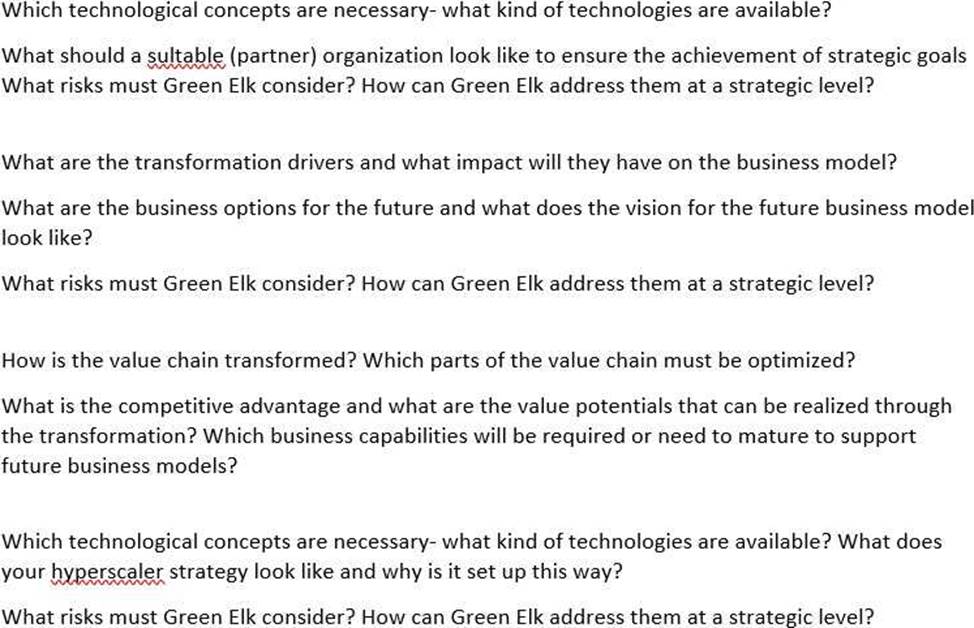Which of the following sets of questions would you ask?
Green Elk & Company is the world’s leading manufacturer of agricultural and forestry machinery. The former company slogan "Elk always runs has recently been changed to "Elk feeds the world" One of Green Elk’s strategic goals is to increase its revenue in the emerging markets of China, India, and other parts of Asia by 80 % within three years. This requires a new business model that caters to significantly smaller farms with limited budgets. You are the Chief Enterprise Architect and the CIO asked you to conduct interviews with the key stakeholders of Green Elk to assess the business strategy. You are planning to interview the owner of the business unit of finished goods.
Which of the following sets of questions would you ask?

A . Which technological concepts are necessary- what kind of technologies are available?
What should a suitable (partner) organization look like to ensure the achievement of strategic goals
What risks must Green Elk consider?
How can Green Elk address them at a strategic level?
B . What are the transformation drivers and what impact will they have on the business model?
What are the business options for the future and what does the vision for the future business model look like?
What risks must Green Elk consider? How can Green Elk address them at a strategic level?
C . How is the value chain transformed?
Which parts of the value chain must be optimized?
What is the competitive advantage and what are the value potentials that can be realized through the transformation?
Which business capabilities will be required or need to mature to support future business models?
D . Which technological concepts are necessary- what kind of technologies are available?
What does your hyperscaler strategy look like and why is it set up this way?
What risks must Green Elk consider?
How can Green Elk address them at a strategic level?
Answer: C
Explanation:
According to the SAP Enterprise Architecture Framework, which is a methodology and toolset by the German multinational software company SAP that helps enterprise architects define and implement an architecture strategy for their organizations, the first phase of the architecture development cycle is the architecture vision, which involves defining the scope, objectives, and stakeholders of the architecture project, and creating a high-level vision of the desired outcome. The questions in option C are aligned with this phase, as they aim to understand and assess the business strategy and transformation drivers of Green Elk & Company, and to identify the value proposition, value chain, and business capabilities that are relevant for the new business model.
The questions in option Care:
How is the value chain transformed? Which parts of the value chain must be optimized? This question helps to understand how the new business model affects the way Green Elk & Company creates and delivers value to its customers, and which activities or processes need to be improved or changed to support the new business model.
What is the competitive advantage and what are the value potentials that can be realized through the transformation? This question helps to understand what differentiates Green Elk & Company from its competitors, and what benefits or opportunities it can achieve by adopting the new business model.
Which business capabilities will be required or need to mature to support future business models? This question helps to identify the skills, resources, and competencies that Green Elk & Company needs to develop or enhance to enable and sustain the new business model.
The other options (A, B, D) are not correct for the set of questions to ask the owner of the business unit of finished goods, because they either skip or misrepresent some of the aspects of the architecture vision phase.
For example:
Option A is not correct because it focuses too much on the technological aspects of the architecture project, such as technological concepts, integration technology, and partner organization. These aspects are more relevant for later phases of the architecture development cycle, such as application architecture or technology architecture. The questions in option A do not address the business aspects of the architecture project, such as business goals, drivers, constraints, or value proposition.
Option B is not correct because it does not include asking about the value chain or the business capabilities, which are important aspects of the architecture vision phase. The value chain describes how Green Elk & Company creates and delivers value to its customers, and the business capabilities describe what Green Elk & Company can do or needs to do to achieve its goals. The questions in option B only focus on the transformation drivers and the future business model, which are not enough to define a comprehensive architecture vision.
Option D is not correct because it also focuses too much on the technological aspects of the architecture project, such as technological concepts and hyperscaler strategy. These aspects are not relevant for interviewing the owner of the business unit of finished goods, who is more concerned with the business aspects of the architecture project. The questions in option D do not address the value proposition or the value chain, which are essential for understanding how Green Elk & Company creates and delivers value to its customers.
For more information on the SAP Enterprise Architecture Framework and its phases, you can refer to SAP Enterprise Architecture Methodology Guide or SAP Enterprise Architecture Framework – Wikipedia.
Latest P_SAPEA_2023 Dumps Valid Version with 48 Q&As
Latest And Valid Q&A | Instant Download | Once Fail, Full Refund

